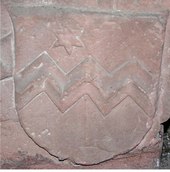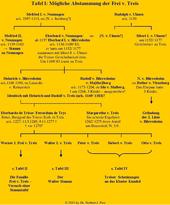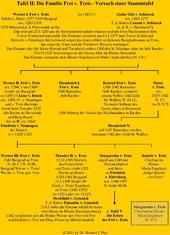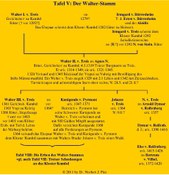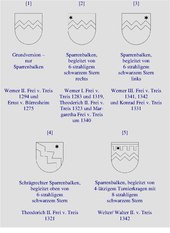Free from Treis
The Frei von Treis were an originally noble knight family in the Moselle town of Treis , who placed the Trier burgraves at Treis Castle between 1270 and 1341 . Treis was already of great importance as the capital of Trechirgau during the Franconian era , where the last Gaugraf died childless before 1120. In the following three centuries several noble families can be found here who named themselves after the place. Since not all bearers of the name had a distinguishing addition such as Gryn, Stetzges, Setzpand etc., a genealogical examination is difficult. The Frei von Treis (Werner-Stamm) stood out from these unfree ministerials as electoral Trier burgraves and court lords. The addition Frei is to be seen as the last attempt to point out the dynastic origin. The second main tribe (Walter tribe) together with the von Schönenberg family provided the court lords in the Kumbder court . There were also several related individuals. The blessed Beatrix von Engelport probably also came from the Treiser nobles.
origin
It is very likely that the noble knights von Treis came from the von Bürresheim dynasty family , who had their headquarters near Mayen . In addition to the hereditary burgrave office zu Treis, the lead names Eberhard, Heinrich and Rudolf as well as the relevant documents speak for this , while the often cited similarity to the coat of arms, namely the zigzag bar, has no special meaning in this context. As far as we know today, Eberhard von Bürresheim, son of Mefried I von Neumagen , was an ancestor of the Treiser nobles and was probably married to a woman from Isenburg . One can adopt five sons for Eberhard von Treis. Most of the traces left by Werner and Walter, while references to Sibert, Otto and Peter are rather sparse.
Werner-Stamm (Frei von Treis)
Werner I. Frei von Treis had married Uda / Oda von Schöneck - probably at the beginning of 1263 . On January 23 of this year, she and her descendants were released from the Reich Ministry by King Richard and transferred to the Archbishop of Trier. The inheritance of the Treis burgraviato was expressly linked to the condition that the children of the couple of both sexes were only allowed to marry Trier ministerials. Werner was already a ministerial officer in Trier and was given the attribute Frei for the first time on November 9, 1277. Werner was first mentioned as a burgrave in 1270 in connection with a donation (Priorswald) to the Maria Engelport monastery .
The noble knights of Treis are a typical example of the decline of a noble family that was often observed at the time; their decline began as early as the second half of the 13th century. The successive sale or giving away of the last remnants of their own property, "mismarriages" and entering the monastery were factors that led to the loss of importance and at least promoted the extinction of the Treis noblemen.
A total of four children of the married couple Werner I. Frei von Treis and Oda von Schöneck are known, namely Werner II., Theoderich I., Konrad and Mechthild (Metze). Werner II Frei von Treis must have married Lisa von Bruch, daughter of the nobleman Theoderich Herr von Bruch and Beatrix von Esch, in early 1295 or shortly before. He probably died in 1304/1305 and was apparently survived by many years by his father, who was still sealed as a burgrave in 1319.
Werner I. Frei von Treis was followed by his grandson Theodoric II as Burgrave of Treis and in 1341 by his brother Werner III. Free from Treis.
The following are known as the Electorate Burgraves of Treis:
- Eberhard von Neumagen / von Bürresheim and Siebert von Ulmen = around 1152–1169 / 83
- Heinrich von Bürresheim / von Treis = 1169/83
- Eberhard von Treis = around 1270
- Werner I. Frei von Treis = 1270-1319
- Theodor I. Frei von Treis = 1320-1341
- Werner III. Free from Treis = 1341
With Werner III. and his brother Theodor II, the Frei von Treis died out in the third generation of the male line. While her sister Margaretha reproduced, the other sister went down in regional history as the blessed Beatrix von Engelport . In 1435 and 1445 the Pyrmont - Ehrenberg claimed the inheritance of the Frei von Treis.
Walter tribe
Treis noblemen of the Walter tribe were bailiffs (provisors) of the Kumbd monastery at the end of the 13th / beginning of the 14th century. They were responsible for the jurisdiction in the Kumbder court. The clan made very generous gifts to the Kumbd Monastery, especially in the 1280s and 1290s.
The crest
The basic version of the coat of arms of the Frei von Treis is a red zigzag bar in silver [1]. It is noticeable, however, that almost all Frei von Treis also use a six-pointed star as a symbol. Walter II von Treis - documented for 1342 - added a tournament collar in addition to an eight-pointed star [5]. Such marks, especially a tournament collar, often served older sons as a distinguishing feature from their father's coat of arms. After the death of the father and the assumption of the inheritance it was often put down again, but not always.
With the Frei von Treis the star - except in 1294 with Werner II. [1] - seems to have been an integral part of the coat of arms. Here it was the other way around, because the father had a six-pointed star on the top right heraldic [2]. In the same way, Werner II's presumed daughter Margaretha von Treis, who was married to Friedrich von Ehrenberg, was sealed around 1340. His son of the same name, Werner III. Frei von Treis, in turn, led the six-pointed star at the top left in 1342, as did his brother in 1331, the Karden canon Konrad Frei von Treis. Werner II's son Theodoric II of Treis, on the other hand, sealed the seal in 1321 with an oblique left zigzag bar at the top left, accompanied by a six-pointed star [4]. He could therefore be identical to de Trijs mentioned in the Balduins, as one of the castle men of Archbishop Baldwin of Trier on the Neuerburg near Wittlich . However, it should be remembered that Theodoric II von Treis sealed the seal two years later on November 13, 1323 with a horizontal zigzag bar and star in the right upper corner [2]. That doesn't necessarily have to be a contradiction. Perhaps after the death of his grandfather Werner I. Frei von Treis, who was still alive at least 1319, he had adopted his coat of arms.
It is generally assumed that the Frei von Treis have adopted their coat of arms, the zigzag bar, from their Bürresheim ancestors. This assumption cannot be confirmed. No coat of arms has been handed down directly for the original Bürresheim line, but there are good reasons to assume that it was “two red bars in silver”. The second line from Bürresheim carried the Virneburg diamond coat of arms. It was not until the father-in-law of Walter I von Treis, Ernst von Bürresheim, that he changed the coat of arms when he chose the rafter beam from 1275 onwards. Incidentally, this happened at the same time as the first seal handed down by Werner I. Frei von Treis. He used 1277 rafter beams and star [2]. Ernst von Bürresheim's father was Cuno von Virneburg, called von Bürresheim, and a great cousin of Werner I. Frei von Treis. Eberhard von Neumagen / Bürresheim was their great-grandfather, whose daughter, who was not known by name, married the Rether von Virneburg and with him founded the second Bürresheimer line, which carried the Virneburg coat of arms (4: 3 gold diamonds in red). With the marriage of Irmgard von Bürresheim, daughter of Ernst, with Walter I. von Treis, both lines reunited.
Bornheim gen. Schilling suspects a radical change of coat of arms for reasons of prestige for Ernst von Bürresheim. The Virneburg ancestors were socially relegated and so the rafters of the maternal Manderscheid ancestors counted significantly more. What induced the Treiser to use this element at the same time has not yet been clarified. Had they coordinated with the Bürresheimers?
Strasser describes the helmet ornament of Frei von Treis as "a tree or bush growing out of a hollow vessel which was adorned with the coat of arms" and refers to "Diedrich Frie von Treis, 1351 Burggraf zu Treis". According to Gruber, the crest was "a miter marked like the shield with a green rooster bush on top".
literature
- Werner Bornheim called Schilling : On the history of the von Bürresheim in the Middle Ages . In: Annals of the Historical Association for the Lower Rhine 1956 Volume 158 pp. 104-138.
- Otto Gruber: Coats of arms of the Middle Rhine-Moselle nobility in Landeskundliche Vierteljahresblätter 1962–1967, (published in continuations).
- Felix Hauptmann : Ten coat of arms groups from the Middle Rhine . In: Yearbook of the Heraldic Society "Adler" in Vienna No. 10 (1900) pp. 1–43.
- Jean-Claude Loutsch and Johannes Mötsch: The coats of arms of the Trier castle men around 1340 . In: Yearbook for West German State History, 18th year Koblenz 1992 pp. 1–180.
- Norbert J. Pies: On the history of Maria Engelport Monastery. Volume VIII: Engelport and Treis-Karden. Aspects of common history . Erftstadt-Lechenich 1998.
- Norbert J. Pies: The green knights of Treis. A study of the family of the Gryn v. Treis . In: From "Häckedetz unn Stifthere". History and stories of Treis-Karden Volume 1. Treis-Karden 2004 pp. 104–124.
- Norbert J. Pies: Why were the Treiser castles a bone of contention between the emperor, count palatine and archbishop? In: From "Häckedetz unn Stifthere". History and stories of Treis-Karden Volume 3. Treis-Karden 2006 pp. 67–82. It contains detailed sources and further information on the topic.
- Norbert J. Pies: Reflections on the early local nobility . In: From "Häckedetz unn Stifthere". History and stories of Treis-Karden Volume 4. Treis-Karden 2007 pp. 126–131.
- Norbert J. Pies: The Frei v. Treis and her relatives. With a contribution by Markus Sausen . Erftstadt-Lechenich 2011 ISBN 978-3-927049-51-2
- G. Strasser: The coat of arms of the Lords of Manderscheid in the Eifel, on the Saar and Moselle . In: Mitteilungen der Westdeutsche Gesellschaft für Familienkunde Volume 2 No. 4 (1919) pp. 110–113, No. 5 (1919) pp. 138–142 and No. 6 (1920) pp. 169–173.
- Willi Wagner: The Cistercian convent Kumbd . Kastellaun 1973.
